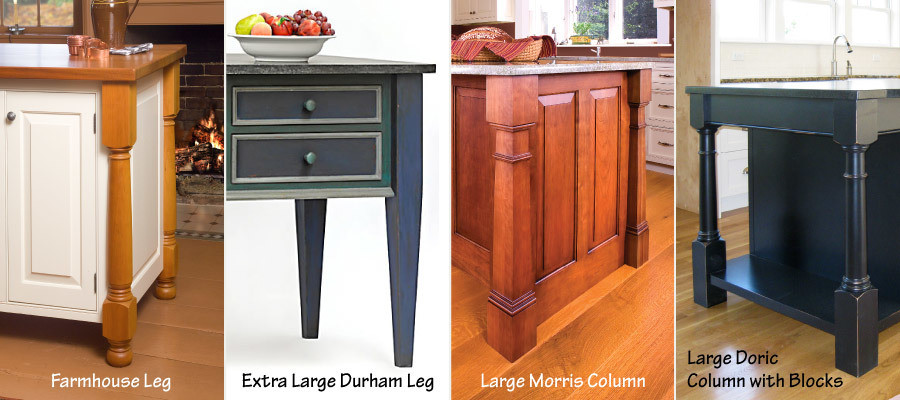Stylish Kitchen Island Legs: Boost Your Kitchen Design
Crucial Tips for Choosing the Perfect Eating Table for Your Kitchen Area
Selecting the excellent dining table for your kitchen area is more than simply an issue of preference; it demands a complete understanding of your space and needs. Begin by measuring your readily available area to ensure sufficient clearance for motion. The shape of the table plays a pivotal role; while rectangle-shaped tables fit bigger locations, round ones foster affection, and extendable options provide flexibility. Material option is equally crucial, with woods giving resilience and glass lending a contemporary touch. Lastly, the table must balance with your kitchen area's aesthetic appeals and accommodate your family members pleasantly. What other elements might affect this crucial choice?
Procedure Your Area
Picking the suitable eating table starts with a careful assessment of your available room. This foundational step makes sure that the table not only fits conveniently within the room however additionally matches the total design and performance of your eating area.
Think about the circulation of movement around the table. It is necessary to leave appropriate area for chairs to be pulled out and for individuals to walk around the table without blockage. A general general rule is to allow a minimum of 36 inches of clearance from the side of the table to the nearby wall or furniture piece. This ensures ease of access and comfort during meals.
In addition, consider the variety of people you typically delight and whether you need extra room for guests. Choosing an extendable table can offer flexibility, enabling you to accommodate varying numbers of restaurants. By precisely measuring your area, you lay the foundation for choosing a table that improves both the aesthetics and performance of your dining area.
Select the Right Shape

On the various other hand, round tables are superb for smaller kitchens or intimate gatherings, as they advertise discussion by allowing every person to deal with each other. They likewise provide a sense of coziness and can fit well in tighter rooms due to their lack of sharp edges. Oval tables offer the best of both worlds, integrating the length of rectangular tables with the intimacy of rounded ones, making them versatile for various settings.
Square tables are an additional option, particularly fit for square-shaped rooms. They create a modern and in proportion appearance, promoting an equivalent dining experience for all seated.
Product Factors To Consider
When selecting an eating table, material factors to consider are paramount in figuring out the table's resilience, upkeep needs, and general visual. Wood is a traditional selection, providing classic appeal and robustness.
Glass-topped tables supply a modern, sleek appearance and can make a room show up larger as a result of their transparency. They need constant cleaning to protect against smudges and finger prints. Furthermore, tempered glass is advised for its additional stamina and safety and security.

Lastly, composite products like MDF (Medium-Density Fiberboard) or plywood are economical alternatives. These materials can mimic the look of strong timber but might not use the very same longevity. They are typically much easier to tidy however can be at risk to water damages if not properly secured.
Eventually, the choice of product must line up with your kitchen's design, your way of life needs, and your budget restraints. (kitchen island legs)
Seating Capability and Comfort
Exactly look here how do you identify the best seating capacity and convenience for your eating table? For a family members of 4, a rectangular table of 48 inches long or a round table with a 48-inch size is typically enough.
The elevation of the table ought to preferably be around 30 inches, offering a well balanced ergonomic position for seated restaurants. Chairs ought to have a seat height of 18 to 20 inches to make certain a comfortable eating stance.
Style and Looks
Picking a table that fits your design and aesthetic appeal involves balancing individual taste with the existing design of your dining space. The table is frequently the centerpiece of the kitchen, and its layout needs to enhance the general style of the space. Whether your kitchen area flaunts a contemporary, minimal look or a rustic, farmhouse charm, the table you pick need to balance with these elements to create a natural and inviting atmosphere.
Think about materials thoroughly; timber supplies an ageless charm and can range from rich mahogany for a traditional want to lighter oak for a modern feeling. Metal and glass tables, on the other hand, can introduce a sleek, commercial side to your kitchen click here for info area. Do not overlook the table's shape-- rectangular tables are traditional and flexible, while round and oblong alternatives can cultivate an extra intimate eating experience.
In addition, pay very close attention to coatings and details. A distressed coating could include character and warmth, whereas a glossy surface area can add to a tidy, modern-day visual. Ultimately, your table should not only fit perfectly into your kitchen's design but also show your personal design, raising the room both functionally and visually.
Verdict
In conclusion, selecting the optimal eating table for a cooking area necessitates cautious assessment of area, shape, material, seating ability, and aesthetic my site harmony. Inevitably, an appropriate dining table fosters an inviting atmosphere and fits the family conveniently, thus boosting the dining experience.

When picking an eating table, material considerations are paramount in establishing the table's durability, maintenance requirements, and general visual. For a household of four, a rectangle-shaped table of 48 inches long or a round table with a 48-inch size is normally enough.
Don't overlook the table's form-- rectangular tables are versatile and traditional, while round and oval alternatives can promote an extra intimate dining experience. kitchen island legs.